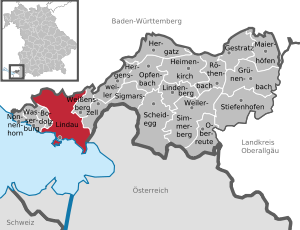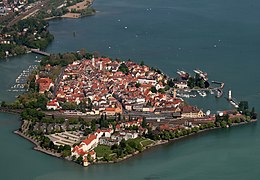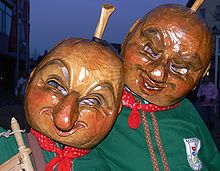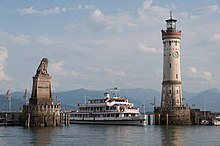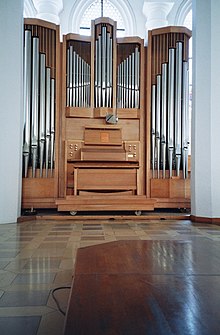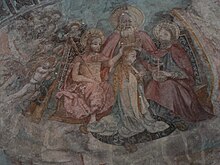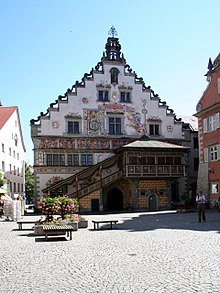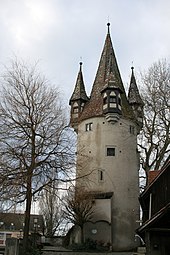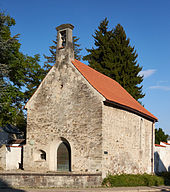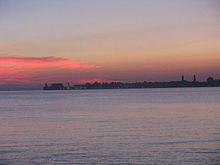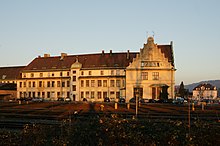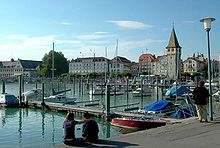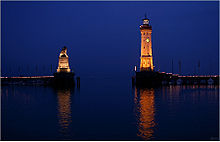Lindau (Lake Constance)
| coat of arms | Germany map | |
|---|---|---|

|
Coordinates: 47 ° 33 ' N , 9 ° 41' E |
|
| Basic data | ||
| State : | Bavaria | |
| Administrative region : | Swabia | |
| County : | Lindau (Lake Constance) | |
| Height : | 401 m above sea level NHN | |
| Area : | 33.05 km 2 | |
| Residents: | 25,512 (Dec. 31, 2019) | |
| Population density : | 772 inhabitants per km 2 | |
| Postal code : | 88131 | |
| Area code : | 08382 | |
| License plate : | LI | |
| Community key : | 09 7 76 116 | |
| City structure: | 48 parts of the community | |
City administration address : |
Bregenzer Strasse 6–12 ( Reutin ) 88131 Lindau (Lake Constance) |
|
| Website : | ||
| Lord Mayor : | Claudia Alfons (independent) | |
| Location of the city of Lindau (Bodensee) in the district of Lindau (Bodensee) | ||
Lindau (Bodensee) ( , Alemannic : Lindau / Lindou or Linda / Linde ; formerly Lindau in Lake Constance and not "Lindau am Bodensee") is a large district town and the administrative seat of the district of the same name in the Bavarian administrative district of Swabia .
The city, which was a free imperial city until 1803 , is located on the eastern bank of Lake Constance in the triangle between Germany , Austria and Switzerland ; its historical center is the old town, which is a listed building, with the magnificent town hall (built 1422–1436) on Maximilianstrasse on the island of Lindau . In 1496, Lindau was the site of a Reichstag .

geography
overview
The historic old town of Lindau is located on the island of the same name in Lake Constance, which has an area of 0.68 km² and has around 2800 inhabitants. The population of the island was already much higher, for example in the 1900 census it was found to be 5853. The island formerly consisted of three sub-islands (rear island, main island and castle / Römerschanze), in 1968 the parking lot P5 was built on the rear island. The island is connected to the mainland by a railway embankment and a road bridge.
The small island of Hoy , which was created as an artificial bathing island in the 1920s, also belongs to Lindau . There is also a block of gneiss in the shallow water, about 40 meters from the so-called Rear Island (part to the west of the railway embankment; also known as the “Western Island”), which is called the Hexenstein . This no longer belongs to the urban area.
The southern part of the urban area is relatively densely built along the shoreline. Outside this settlement area, there are incorporated villages in the northern part, of which Ober- and Unterreitnau are the largest. The area is mainly used for agriculture, with fruit growing dominating large parts; the meadows and cultivated areas are broken up by forest areas.
With the mainland districts of Schachen , Aeschach , Reutin and Zech (from west to east), the city of Lindau has more than 12 km of Lake Constance. The natural shape of the banks of Lake Constance in the Lindau area is a belt of reeds, followed by wet meadows and rising solid terrain.
geology
The urban area of Lindau is characterized by glacial changes from the Würm Ice Age . In terms of nature, the southern part of the urban area near the banks belongs to the Lake Constance basin , while the northwestern area around Ober- and Unterreitnau belongs to the West Allgäu hill country . In the southeastern part of the Lindau urban area, post-glacial lake deposits can be identified.
In the north of Lindau there are often young moraines with drumlins , in the north a drumlin field has been designated as a geotope by the Bavarian State Office for the Environment , as well as a boulder in Hochbuch. The transition from the Lake Constance basin in the south to the Drumlin hill country in the north is formed by gravel terraces and moraine walls.
Hydrology
In the urban area of Lindau five brooks flow into Lake Constance (named from west to east): Giebelbach, Oberreitnauer Ach, Rickenbach / Oberreutiner Tobelbach, which divides in its lower reaches, and the Leiblach , which forms the state border with Austria. The Oberreitnauer Ach feeds, among other things, from the orographically left tributaries Motzacher Tobelbach and Wolfsbach; in the extreme northwest the Nonnenbach flows through the urban area. The following larger ponds are also located in the urban area: Köchlinweiher (Reutin), Sägeobelweiher and Oberer / Mittlerer Klosterweiher (near Heimesreutin) and the Aspachweiher near Oberreitnau. Lindau also has a small share of the Degersee .
climate
The annual precipitation is 1420 mm and is thus in the upper tenth of the values recorded by the measuring points of the German Weather Service . Over 96% of the statistically recorded locations show lower values. The driest month in Lindau is February. It rains most in June, which has an average of 2.2 times more rainfall than the month of February. The seasonal fluctuations in precipitation are in the upper third of all statistically recorded locations. In over 98% of these places, the monthly precipitation fluctuates less than in Lindau.
Neighboring communities
In the south, the urban area of Lindau borders on Lake Constance. The neighboring communities clockwise from west to east:
- Wasserburg ( Lindau district )
- Bodolz ( district of Lindau )
- Kressbronn ( Lake Constance district , Baden-Württemberg )
- Tettnang ( Lake Constance district , Baden-Württemberg )
- Achberg ( Ravensburg district , Baden-Württemberg )
- Weißensberg ( Lindau district )
- Sigmarszell ( Lindau district )
- Hörbranz ( Bregenz District , Vorarlberg , Austria )
- Bregenz ( Bregenz District , Vorarlberg , Austria )
Among the neighboring communities are Wasserburg and Kressbronn in the west and Bregenz in the far east, also on Lake Constance.
The border with the Austrian communities of Hörbranz and Bregenz is the middle of the Leiblach .
The municipality of Wasserburg in the west borders Lindau in two sections, interrupted by the municipality of Bodolz . In the southern section, on Lake Constance, Lindau and its Schachen district border the Reutenen district in Wasserburg; in the northern section, Lindau and its district Unterreitnau borders on the Wasserburg district of Hengnau.
Community structure
The urban area of Lindau includes the actual core city of Lindau, which in turn consists partly of former communities and incorporated villages outside the urban settlement structure. Larger districts that take on infrastructural functions and accommodate a primary school, for example, are marked in bold. A total of 48 districts belong to the city of Lindau.
Districts in the core city
| No. | Districts | Population Census May 25, 1987 |
|---|---|---|
| 1 | Aeschach (with Giebelbach) | 4,379 |
| 2 | Bad Schachen | 1,261 |
| 3 | Degelstein | 274 |
| 4th | Hochbuch | 1,274 |
| 5 | Hoyren | 1,456 |
| 6th | Oberreutin | 1,660 |
| 7th | Reutin | 4.185 |
| 8th | Rickenbach | 226 |
| 9 | Schönau | 316 |
| 10 | island | 2,755 |
| 11 | Wannent (h) al | 1,323 |
| 12 | Zech | 1,798 |
| Lindau | 23,610 |
- Villages and places to live
The most important parts of the community outside the city center are the parish villages of Oberreitnau (1255 inhabitants as of 1987) and Unterreitnau (120 inhabitants). Smaller villages in the municipality are Bechtersweiler , Eggatsweiler , Heimesreutin , Höhenreute , Hörbolz , Motzach , Niederhaus , Oberhochsteg , Oberrengersweiler , Rengersweiler , Rickatshofen and Streitelsfingen . The hamlets Dachsberg (formerly Daxberg), Dürren , Giebelbach , Goldschmidsmühle , Greit , Hangnach , Hörbolzmühle , Humbertsweiler , Lattenweiler , Paradies , Sauters , Sulzenberg , Waltersberg are also located . The following wastelands are also in the municipality: Bahnholz , Gitzenweiler , Grünlach , Hugelitz , Schönbühl , Sulzenmoos , Unterwaltersberg , Wiesfleck .
The village of Unterhochsteg and the desert areas of Achrain , Ebnit and Soyers are not officially designated parts of the municipality.
Markings There are six markings in the area of the city of Lindau , which correspond to former municipalities:
| District number |
District | Area 1904 ha |
Incorporation | Area 2015 ha |
Today's districts |
|---|---|---|---|---|---|
| 7940 | Lindau (Bodensee) (island) | 59.43 | original city center since 1079 when the market was moved to the island |
70.8 | island |
| 7937 | Hoyren | 384.42 | Feb. 1, 1922 (after spin-off 1818) | 387.7 | Hoyren , Schachen , Schönau , Degelstein |
| 7938 | Aeschach | 442.39 | Feb. 1, 1922 (after spin-off 1818) | 443.4 | Aeschach , Hochbuch |
| 7939 | Reutin | 899.96 | Feb. 1, 1922 (after spin-off 1818) | 833.4 | Reutin , Zech , Oberreutin, Rickenbach |
| 7936 | Oberreitnau 1 | 954.02 | Jan. 1, 1976 1 | 947.5 | Oberreitnau and surrounding villages |
| 7935 | Unterreitnau 1 | 620.17 | Jan. 1, 1976 1 | 621.2 | Unterreitnau and surrounding villages |
| Lindau | 3360.69 | 3304.0 |
1 On July 1, 1971, the former municipalities of Oberreitnau and Unterreitnau became the new municipality of Reitnau , which in turn was incorporated into Lindau on January 1, 1976.
The area changes between 1904 and today are explained by various small changes in the course of the respective district boundary. By increasing the land area on the island, the area of the Lindau district has also increased. The Reutin district, on the other hand, was reduced in size in 1952 by the transfer of an area around the hamlet of Oberhof to the community of Weißensberg.
Demographics
The 2011 census showed a population of 24,491, of which 11,588 were male and 12,904 female. 10,630 inhabitants or 43.6% are Roman Catholic . There is a large Protestant minority of 5,730 people, which corresponds to a share of 23.5%. 930 people (share: 3.8%) answered the question about religious affiliation with “other”, 6,400 (26.3%) with “without confession”.
In Lindau, the proportion of foreigners is 14.2% (3,470 people), the proportion of residents with a migration background is 24.8% (6,050 people). Both values are above average, both nationally and nationally.
Population development
Lindau (Lake Constance) grew by 974 inhabitants or around 4% between 1988 and 2008. Between 1988 and 2018, the city grew from 23,699 to 25,490 by 1,791 inhabitants or 7.6%.
The population figures from 1840 onwards relate to today's municipality area (status: 1978).
| Population development | |||||||||||||||
|---|---|---|---|---|---|---|---|---|---|---|---|---|---|---|---|
| year | 1840 | 1900 | 1939 | 1950 | 1961 | 1970 | 1987 | 1991 | 1995 | 2000 | 2005 | 2010 | 2015 | 2017 | |
| Residents | 6,902 | 11,266 | 17,044 | 21,884 | 25,684 | 26,773 | 23,619 | 24,623 | 24.163 | 23,874 | 24,425 | 24,772 | 25,132 | 25,253 | |
Etymology and Heraldry
In 882 a St. Gallen monk wrote the document which contains the oldest reliable written evidence of the name Lindau : The name means "island on which linden trees grow". The city coats of arms and seals, which have been documented since the 13th century and which either show a complete linden tree or symbolize a linden leaf, are a reminder of this to this day. Even today the tree grows many times in the cityscape.
There are various theories about the origin of the place name: Primarily, the origin of the word part -au is traced back to Old High German ouwa "island", where Lind- stands for linta / linda "linden tree".
Another theory about the origin of the place name is that the name part Lind- is derived from the Celtic Lindon , which means “liquid, drink” and also “pond, small lake”. Which is more likely for place names or water names such as B. Lintgen (Luxemburg, Lindissa, Lindiacum ), Limmat (Switzerland, river, * Lindo-magos > ad fluvium Lindimacum 771, de ripa Lindimagi fluminis 820?) Etc. is not secured here because an explanation of the second component - au is missing.
The coat of arms shows "a green linden tree with roots in silver". This linden tree, which speaks for the place name, was already used as a coin image around 1180. The number of leaves on the ever green tree changed between three and fifteen over the centuries. The Lindau flag is divided lengthways into green and white (heraldic silver).
To distinguish it from other places with the same name, the addition "i B" or "i. B. "(for" in Lake Constance ") added.
history
Early history
Early traces of settlement in the urban area were found on the ridge near the former Catholic cemetery of Aeschach, on the mainland opposite the island. Traces of Roman settlement were discovered here in 1878 and the foundations of a former villa suburbana were exposed in 1888. The building with hypocaust heating dates from the second century AD and is now located in the so-called "Roman Park". According to a coin find, a Roman past is also popularly assumed for today's "Römerschanze", one of the three former islands of Lindau, for which the older name "castle" exists. Although such coin finds are of little informative value, it can be assumed that “a natural base like the Lindau Island” served the local Romans and Romans as a place of retreat during the early migration period; However, a larger settlement cannot be assumed.
Foundation of the monastery and early urban development
Lindau was first mentioned in a document as "Lindoua" or "Lintoua" in 882 in a St. Gallen deed of gift: A Cunzo or Kunzo gave goods in Tettnang and Haslach "ad Lintouam". However, this mention can only refer to the Lindau women's monastery , which was the only legal entity on the island of Lindau at that time. The only point of reference for the foundation and founder of the monastery is the so-called Ludovicianum , a partially forged document by Ludwig the Pious , from which privileges of the monastery were derived. Authentic parts, however, mention Adalbert von Rätien from the Burchardinger family as the founder. The Lindau historiography assumes that Adalbert founded the Kanonissenstift between 810 and 820 and had the Udalrichinger Ruadpert, count in the Argengau and Linzgau , who had been defeated at Zizers , buried in the newly founded monastery. An early ecclesiastical center of the island is the Peterskirche , until 1180 the sole parish church of the island Lindau. It may even exist as a fisherman's church before the monastery, which can be classified as the actual nucleus of urban development.
The market was originally located in Aeschach on the mainland. The favorable location at the crossroads of the Bregenz - Buchhorn and Lindau - Kempten (Allgäu) traffic routes has ensured relatively continuous settlement continuity since the Roman conquest. In the course of the uncertain conditions of the investiture dispute , the market was moved to the island in 1079 for security reasons.
Wine, fine fruit and vegetables from the cultures of the St. Gallen monastery as well as flax and the hemp needed for shipbuilding were traded. The market was supplied with lard, cheese and cattle from the western Allgäu and the Bregenz Forest, and the Upper Swabian farmers brought in grain. Long-distance trade with the south soon joined this local trade.
Lindau as an imperial city
The parish church of St. Stephan was built around 1180, and Franciscans founded a monastery in 1224 . In 1274/1275 King Rudolf I confirmed the previously acquired city rights. Lindau now appears as an imperial city . Under King Rudolf von Habsburg (reign 1273–1291) the noble lady Guta von Triesen was elected abbess of the noble ladies' monastery in Lindau and ruled it with great fame until 1340.
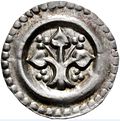
Lindau used its right to mint to eliminate the disreputable reputation of coins and the renewal of bracteate pennies with its own coinage, the so-called Eternal Pfennig .
During civil engineering work on Lindau Island near the former Heka department store (later May; closed since the end of 2005), a climbing tree , which probably dates back to the 14th century, was recovered. Comparable objects on Lake Constance can only be viewed as reconstructions in the Pfahlbaumuseum Unteruhldingen .
For the years 1496/97 Maximilian I had the Reichstag convened in the Lindau Town Hall (today the Old Town Hall). Since the king was waging war in Italy, he was represented by his son Philip .
From the 15th century to 1826, the so-called Mailänder Bote , also called Lindauer Bote, ran on the Viamala between Lindau and Milan . The citizens, who became rich through trade and transport (own Lake Constance fleet) of grain and salt, were able to use and enforce the rights of a free imperial city acquired in the 13th century.
Modern times

From 1500 Lindau was part of the Swabian Empire . The plague spread along long-distance trade and pilgrimage routes around 1500, and a plague epidemic also raged in Lindau at the beginning of the 16th century. This mass extinction had direct consequences for the funeral cult. Because of the overcrowding of the inner-city cemeteries and fear of contamination, the dead were pulled on hearse carts in front of the city walls and buried there. From this time there is still the old cemetery in Aeschach , also at this time the Lindau plague house was built. In 1635 the plague also raged in the villages of the Lindau hinterland, so that the dead had to be buried in the plague cemeteries in Unterreitnau , Wasserburg and Hergensweiler.
In the course of the Reformation Lindau became Protestant in 1528 , in the early years under the influence of the Konstanz reformer Ambrosius Blarer with a tendency towards Zwinglianism . Only later did they turn to Luther , and in 1529 the city was one of the representatives of the Protestant minority ( Protestation ) at the Reichstag in Speyer . Their citizenship demanded the unhindered expansion of the Protestant faith and joined the Confessio Tetrapolitana (Evangelical confession formulation by Martin Bucer ). The women's monastery remained Catholic and the Franciscan monastery, from which the first Reformation preacher came, was closed. Mayor Michael Buchschar signed the Lutheran Agreement of 1577 on behalf of the City Council of Lindau .
During the Thirty Years' War , Lindau was also besieged by the Swedes in 1646/47 (see Naval War on Lake Constance 1632–1648 ). The Lindau, under the military command of Count Max Willibald von Waldburg-Wolfegg , the commander of the imperial occupation troops, destroyed parts of the siege machinery in the night and fog and repulsed the Swedes. The defenders reached the mainland via the so-called “Little Lake”, which was silted up by swamp.
In 1728 a devastating city fire devastated the monastery district and part of the old town; the reconstruction on the market square took place in the Baroque style of that time.
From 1445 to 1761, 18 people were charged in witch trials in Lindau . Nine defendants were executed or died in custody. The last victim of the witch hunt was Maria Madlener , who was executed on August 4, 1730 in Lindau.
19th century
By the Reichsdeputationshauptschluss Lindau was mediated in 1803 and lost its status as a free imperial city. The thousand-year-old Lindau women's foundation was secularized . Prince Karl August von Bretzenheim , who had received the city and women's foundation, gave the imperial city of Lindau briefly to Austria in 1804 on the basis of an exchange contract concluded in 1803 .
In the Peace of Pressburg , Austria ceded Vorarlberg, and with it Lindau, to Bavaria on December 26, 1805 . In 1806 it was incorporated into the newly proclaimed Kingdom of Bavaria . Parallel to the unrest in Tyrol, there was also a popular uprising against the Bavarian government in Vorarlberg in 1809. In May 1809, Vorarlberg troops under the leadership of Bernhard Riedmiller conquered Lindau and they then made advances as far as Constance . This uprising collapsed again in July of that year.
The connection to the shipping network took place in 1824, to the railway line in the direction of Augsburg as the end point of the Ludwigs-Süd-Nord-Bahn in 1854 with the railway embankment to the island and the connection in the direction of Bregenz in 1872. In 1838 the first iron steamship was opened in Lindau the Lake Constance, the DS Ludwig , put into service.
In 1856 a new port was built with the landmarks Lion and New Lighthouse - the southernmost lighthouse in Germany and the only one in Bavaria.
20th century
In 1922, places on the nearby mainland ( Aeschach , Hoyren and Reutin ) were incorporated under Mayor Ludwig Siebert . Siebert was later appointed the first NSDAP Mayor of Bavaria and after the start of the Nazi dictatorship in 1933, Bavarian Prime Minister.
Lindau kept its garrison with parts of the Infantry Regiment 19 of the Reichswehr after the First World War . When the Wehrmacht was rearminged, pioneer units were added (landing pioneers who received their training on and around Lake Constance) and in 1939 the infantry replacement battalion 488. The two barracks became Péronne and Oberst-von-Bram barracks ( today: Maxhof).
Towards the end of the Second World War , French troops occupied Lindau on April 30, 1945 without a fight. As part of the French occupation zone, the city and district were separated from the rest of Bavaria, which was occupied by the United States, and were given a special status under constitutional law . In 1946 a district presidium was constituted as the highest administrative body. It had competences that are exercised elsewhere by a state authority and was legally independent of the state administrations of Bavaria and Württemberg (or Württemberg-Hohenzollern ). For the next ten years, the area served as a land bridge between the French occupation zones in Germany and Austria .
Only on September 1, 1955, Lindau was constitutionally incorporated into the Free State of Bavaria . Between 1945 and 1949, Hans von Herwarth was the official responsible for the reorganization in the Bavarian State Chancellery .
The annual meeting of the Nobel Prize winners in Lindau and the Lindau Psychotherapy Weeks have resulted in repeated reports from science in Lindau since the post-war period, even though there is no university in the area. Every summer almost 4,000 therapists and analysts come to Lake Constance for the psychotherapy weeks.
In March 2014, Lindau was awarded the contract to host the Small State Garden Show 2021. It is to be held under the motto “Ring of island gardens - nature in the city 2021”.
Incorporations
On February 1, 1922, the previously independent communities of Aeschach, Hoyren and Reutin were incorporated. On January 1, 1976 Reitnau , which had been newly formed on July 1, 1971 by the merger of the former municipalities of Oberreitnau and Unterreitnau, was added.
religion
Denomination statistics
According to the 2011 census , 39.9% of the population were Roman Catholic , 21.8% Protestant, and 38.3% were non-denominational , belonged to another religious community or did not provide any information. Currently (as of December 31, 2018) of the 24,490 inhabitants, 33.8% are Catholic and 17.6% Protestant.
Christianity
The Protestant community belongs to the Evangelical Lutheran Church in Bavaria , the Catholic to the diocese of Augsburg . Lindau and the surrounding communities form a deanery .
In Lindau there are the Protestant churches of St. Stephan (Insel) and St. Verena (Reutin), the Reconciliation Church (Zech) and the Christ Church (Aeschach). There are also the following catholic houses of worship: Munster of Our Lady (Insel), St. Josef (Reutin), St. Ludwig (Aeschach), Maria, Queen of Peace (Zech), St. Pelagius (Oberreitnau) and St. Urban und Sylvester ( Unterreitnau).
Judaism
The Jewish community in Lindau was first mentioned in the 13th century. During the Nazi persecution of Jews (1933–1945) the few Lindau Jews were imprisoned and / or forced to leave the country involuntarily or murdered. A survivor of the concentration camps who was able to reopen his practice in the city in 1945 is known.
In the post-war period there was a reception center in Zech far outside the city for about 30 displaced persons (homeless Jews from the French sector of Berlin).
Islam
The center of the Islamic community is the Fatih Mosque in Lindau. This was founded on June 21, 1985 with 50 members under the umbrella organization DITIB and has been located in Von-Behring-Strasse in the Zech district since 2008. The mosque has around 200 members.
politics
(Lord) Mayor
- 1861–1868: Oskar Stobäus
- 1868–1870: Johannes von Widenmayer
- 1870–1873: Ludwig Britzelmayr
- 1873-1894: Oskar von Lossow
- 1894–1919: Heinrich Schützinger
- 1924–1933: Ludwig Siebert ( BVP , from 1931: NSDAP )
- 1933–1939: Fritz Siebert (son of Ludwig Siebert)
- 1939–1945: Josef Haas
- 1945: Franz Eberth
- 1945–1956: Walther Frisch (CDP)
- 1956–1964: Josef Haas (Free Citizenship)
- 1964–1988: Josef Steurer (independent)
- 1988–2000: Jürgen Müller ( Free Voters / Voters' Initiative Lindau )
- 2000–2012: Petra Meier to Bernd-Seidl (independent, set up by CSU or the Free Citizenship of Lindau)
- 2012–2020: Gerhard Ecker ( SPD )
- 2020− : Claudia Alfons (independent, set up by Lindau Initiative, Bürger Union, FDP)
City council
The 30 seats in the city council have been distributed as follows since the local elections in March 2020:
| Colorful list (BL) | CSU | SPD | Citizens Union (BU) | Free Citizenship (FB) | FW | Young active (YES) | Lindau Initiative (LI) | ÖDP | FDP | AfD |
|---|---|---|---|---|---|---|---|---|---|---|
| 6th | 5 | 4th | 2 | 3 | 2 | 3 | 1 | 1 | 2 | 1 |
The city council consists of the full-time mayor and 30 honorary members. The strongest force is the Bunte List (BL), an ecologically oriented party that takes the place of the Greens in terms of content , followed by the CSU, SPD, Junge Aktive (JA), Freie Bürgerschaft (FB), Bürgerunion (BU), FDP, Free voters, Lindau Initiative (LI), ÖDP and AfD .
Administration building
The seat of the city administration is in the district of Aeschach on the shores of Lake Constance and on the Oberreitnauer Ach (border to the district of Reutin , where the district administration also resides). The historic town hall, which is used for council meetings and for representation purposes, is located in the city center.
Town twinning
-
 A partnership with the French city of Chelles has existed since 1964 . The preparation by war returnees' associations was decisive for this partnership.
A partnership with the French city of Chelles has existed since 1964 . The preparation by war returnees' associations was decisive for this partnership.
Since then, several partnerships have been established between Cheller and Lindau schools; For example, a number of young people from Chell come to Lindau for every children's festival.
-
 The districts of Ober- and Unterreitnau have a partnership with the municipality of Reitnau in Switzerland .
The districts of Ober- and Unterreitnau have a partnership with the municipality of Reitnau in Switzerland . -
 There has been a relationship with Lindau in the Anhalt-Bitterfeld district since 1984 .
There has been a relationship with Lindau in the Anhalt-Bitterfeld district since 1984 . -
 Serpukhov in Russia
Serpukhov in Russia
Cultural and event centers
City Theater Lindau

The Lindau City Theater is Lindau 's municipal theater in Lake Constance. Opened in 1951, the house offers plays, opera and ballet productions from various stages in German-speaking countries, an international concert series with chamber concerts as well as cabaret and cabaret. The Lindau Marionette Opera is also located in the Lindau City Theater. The house has around 700 seats (parquet and two tiers) and an orchestra pit.
Island hall
The Inselhalle is an international event, conference and congress center and is operated by Lindauer Tourismus und Kongress GmbH (LTK). Every year u. a. the Lindau Nobel Laureate Meetings and the Lindau Psychotherapy Weeks take place. The Inselhalle was reopened in 2018 after a thorough renovation and modernization.
Museums

- The former Imperial City Library of Lindau with around 15,000 volumes is a special part of the city archive. It is the largest historical council and citizens' library on the northern shore of Lake Constance. It is likely to be based on the book holdings of the Franciscan monastery, which was dissolved in 1528. It contains more than 140 incumbents .
- The Lindau City Museum , which opened in 1929, was located in the Haus zum Cavazzen on the market square until 2018 and is currently (2019) being renovated. It showed paintings and sculptures from the 15th to the 19th century, Lindau home decor with furniture from Gothic to Art Nouveau, handicrafts, documents on the city's history, historical toys and mechanical musical instruments. Up until 2018, works of newer art were shown in changing special exhibitions in the city museum (e.g. 2011 original drawings by Pablo Picasso , 2012 paintings by Marc Chagall , 2013 works by Joan Miró , 2014 drawings by Henri Matisse , 2015 “color compositions” by Emil Nolde , 2016 Pablo Picasso, 2017 Paul Klee , 2018 August Macke ).
- The new art museum at Inselbahnhof was opened in April 2019. Works by Friedensreich Hundertwasser are exhibited here until September 2019 .
- The Peace Museum of the Pax Christi was established in 1980. It led through the forms of peace and reconciliation with the introduction of well-known and lesser-known personalities. In 1999 it was reopened with a new, more modern concept under the name of Friedenszimmer .
Cultural awards of the city of Lindau
- 2010: Herlinde Koelbl
- 2012: Rudi Spring
- 2014: Manfred Eicher
- 2016: Honest Schempp
Lindau in literature
Lindau was often the subject of literary creation.
- Michel de Montaigne dedicated a chapter in his travel diary to the city, stage on his trip to Italy in 1580/1581. During his stay at Gasthaus Krone , he especially praised the rich cuisine, which is incomparably better than the local French cuisine. He regrets not having brought a cook with him on his trip so that he could have learned the kitchen habits.
- Many works about the island city were created in the romantic era in particular. Hölderlin titled the city in his poem Heimkunft , published in 1801, as "blissful Lindau"; at Mörike it is in the idyllic Lake Constance welcomed "enjoyable city that is beautiful on the island."
- Wilhelm Raabe settled part of the plot of The March Home in the Lindau area.
- Even Carl Gustav Carus moved the city with the surrounding landscape so that he described it in his travel diary of 1806 "richest eyes way."
- The Swedish writer August Strindberg lived in Lindau from January to October 1887 and created the play The Father and the story The People of Hemsö here .
- Horst Wolfram Geißler also set a literary monument to the island city with his novel Der Liebe Augustin from 1921. The protagonist lived in a house on Dammgasse, which today bears the name of "Dear Augustins".
regional customs
Carnival
The Lindau fools guild runs the Swabian-Alemannic carnival . Well-known carnival figures from Lindau are the “rush spirits”, the “plaster boys”, the “Moschtköpf” (whose masks are based on apples and pears) and the “Kornköffler”. Every year on Shrove Tuesday, there is a big fool's jump in Lindau.
children Party
After the Thirty Years War, the Lindau Children's Festival was celebrated for the first time in 1655. The founder was Valentin Heider , who, according to the popular opinion of the neglected Lindau youth, wanted to open up new perspectives. However, recent studies show that the so-called school sermons, introduced in 1655, were not primarily aimed at children and young people, but at their parents, who did not accept the city's school system and wanted to protect the children from the teachers' punishment. (However, this has not been proven.)
Even today this festival is celebrated every year on the fourth Wednesday in July with the lower classes of all schools in the city area. In the morning gunfire announces the festival. Every schoolchild traditionally receives (among other things) a so-called "Butschelle", a circular yeast pastry with grapes and a distinctive, coarse grid pattern. The festivity is celebrated with a flag and garland parade and a large gathering on the north side of the Lindau town hall with a speech by the mayor, the greeting of the representatives from the partner communities such as Chelles and Reitnau and a short poem about Lindau performed by primary school students. The three shouts of "Lindau" with the answer "Up" can be heard again and again among participants and in the audience. In the afternoon, the festival turns into a general decentralized folk festival in the districts.
dialect
Traditionally, Lindau belongs to the area of the Bodenseealemannic dialect group within the Alemannic dialects . In the last few decades the original dialect has been exposed to strong influences from Swabian , Bavarian and standard German , so that the peculiarities of the Lindau dialect are dying out; outside of the rural areas, this development has already largely taken place. The characteristic gsi (been) can be used to distinguish the original Lindau dialect from Swabian. The Lindau dialect is still peculiar to the fact that the plural form of the 3rd person in the present tense is formed with the ending -end .
The following example sentences illustrate the Lindau dialect. The language follows the works of the architect and dialect poet Heinrich Götzger , which differs in some points from the pronunciation tradition of the Lindau region (e.g. Stoe instead of Stui / Stua for standard German stone ).
- Isch d'Blueme do gäl, ka'sch mer des seage? - Des ka i der gli seage: Noe, lueg halt amol hi, 's Blüemle isch et gäl, des isch blou.
- Is the flower there yellow, can you tell me? - I can tell you right away: No, just take a look, the little flower is not yellow, it is blue.
- Woescht as o? The lake is too frozen! I mecht ussegoh. - Des isch bode gfährle, Büeble, des lifts! Due et uf it's gange, think about it!
- Do you know it too? The lake is frozen over! I want to go out. - That's pretty dangerous, boy, it won't keep (you) off! Don't go on the ice (don't ... go), remember (me)!
- Bish bigot a sick! Early hond d'Lit no A'schtand ghet.
- You are really (by God) useless! In the past people still had decency (had ...).
- I hon as der scho etle Mol gset. I ho bigott gnue to due.
- I've told you several times. I really have enough (by God) to do.
Attractions
Cityscape and ensembles
The old town is located on the island of Lindau and has a largely intact cityscape that reflects the rich history of the formerly free imperial city. The island is under ensemble protection. Another focus is the villa colony on the Schachen shore of Lake Constance.
→ The list of architectural monuments in Lindau (Lake Constance) provides detailed information on all architectural monuments and a general architectural outline of the city
Harbor entrance
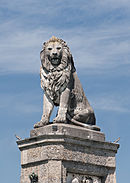
The entrance to the port, where u. a. the Lake Constance scheduled boats from Bregenz, Rorschach and Friedrichshafen are bounded by the new lighthouse from 1856 on the west side and by the Bavarian lion on the east side. The 6 m high, armored lion sits, leaning on its front paws, on a three-tier pedestal from Nagelfluh and looks towards the Swiss bank. Before 1856 it was cut into six blocks from a Kelheim marble block by Johann von Halbig and weighs approx. 70 t. The former pier was built in 1812 by the Mehrerau monastery using blocks of Rorschach sandstone . It was completely demolished in 1986 due to the risk of collapse and rebuilt almost in its old form from South Tyrolean sandstone. It enables a handling of the lion statue.
Maximilianstrasse
The Maximilian Street is part of the pedestrian zone and the main street of the island city. Here you will find a number of well-preserved town houses and craftsmen's houses from the 16th and 17th centuries with arcades , bread arbors (bakery), crane dome , the typical carved window pillars, bay windows and the half-timbered facades that are partially (traditionally as fire protection) plastered over.
City fortifications
The fortification of the built-up part of the island essentially originated in the 12th and 13th centuries. The remainder of an older, narrower system of fortifications, probably created in connection with the monastery founded in 810/820, can be assumed to be in the Heidenturm in the northeast tip of the island at the transition to the mainland. The tower of this first parish church, which was built around 1425 on foundations of the 11th century, originally served to secure the fishermen's and ship's settlement that was built in the northwest corner of the island around the elevated Peterskirche and the former land at today's Paradiesplatz. The step-by-step walling of the main island begins with the planned expansion of the town center to the west to the moat in the 12th century.
The move of the western wall was accompanied by the island moat, which was probably built in the early 13th century and at the same time separated the so-called “rear island” from the “main island”. The course can still be seen in today's streets Unterer Inselgraben, Inselgraben , and Zeppelinstrasse .
The wall section running to the east of the Inselgraben was built over with the western row of houses on Hinteren Metzgergasse after the Vorderen Insel was included in the fortification, or in 1811/12 it was demolished with the exception of small remains.
The course of the north wall leading to the former Landtor is recognizable and its substance is partially preserved along Zeppelinstrasse and the row of houses on the wall .
While the south side of the island with the port moved here was mainly secured by the former fore-island "Auf Burg" (the so-called Römerschanze ) and the Mangturm built around 1200, the fortifications were concentrated on the west and north sides of the island. From 1500 the fortifications were expanded to include and secure the then undeveloped western half of the island; in the process, the jumps (Karlsbastion, Powder Hill, Sternschanze and Lindenschanze) were laid out and in 1508 the Powder Tower was built at the westernmost point of the island.
The last thorough reinforcement of the fortification took place in the first half of the 17th century with the construction of further bastions and entrenchments: Ludwigsbastion and the remains of the Maximiliansschanze on both sides of the land gate (today each included in the Oskar Groll facilities) as well as the Gerberschanze , a trapezoidal bastion protruding into the lake on the southeast side of the island.
Since the beginning of the 19th century, the walls and gates have been torn down except for the aforementioned remains. The stone material was mainly used in the enlargement and modernization of the port in the years 1811 and 1853 to 1856.
Churches
Münster "Our Lady"
The origins of the church on the market square, in the eastern part of the island of Lindau, go back to the year 810. The church (formerly Collegiate Church of the Assumption) was built after the town fire of 1728 in the years 1748–1752 by the baroque master builder of the castle and the church on Mainau Island , Johann Caspar Bagnato . Inside the Catholic parish church, which burned down completely in 1922, there are baroque ceiling paintings and a rococo interior with splendid red and gold decor. The nave ceiling, which collapsed in 1987, has now been renovated.
Evangelical Church of St. Stephen
The largest church in the city is right next to the Cathedral of Our Lady on the city's market square. The building with a wrought iron balcony on the curved facade goes back to a three-aisled Romanesque pillar basilica from 1180. After several extensions, the church was given its current exterior shape around 1506.
The altars and the delicate stucco were redesigned in the Rococo style in 1781/1783 and are now of Protestant simplicity. The wooden vaulted ceiling also dates from that time. A special feature is the 200 year old pews in the community. Since Lindau did not initially follow the Lutheran Reformation , but the confession of the Swiss reformer Zwingli , the church was redesigned accordingly. The pulpit is in the middle of the church, and the backs of the pews can be folded down so that you can see both the altar and the pulpit. The choir windows are from 1965.
The onion dome is 58 m high and carries a 6.5 ton four-part bell. The big bell was cast by Leonhard Ernst in Lindau in 1608 and fell from the tower during the war-related delivery in 1943. It apparently remained intact, survived the war in the Hamburg bell cemetery and was hung up again. She jumped on December 24, 1961. The Nördlingen company Lachenmeyer welded the crack three times . After jumping for the fourth time in 1992, the Bachert bell foundry cast a new bell in 1993. The now unusable bell, which has a mass of approx. 3.8 t and a diameter of 1.76 m and on which the coats of arms of Lindau and other imperial cities are depicted, was then exhibited at the base of the tower. Since October 2010 it has been in a more representative place in front of the west gable.
The main organ is the seventh work in the history of this church. The middle part of their prospectus dates from 1783 and was then in the choir room. When the church was rebuilt in 1860, the organ was placed on the west gallery and supplemented with 16 'pedal towers. In 1924, the G. F. Steinmeyer company in Oettingen built a new plant with 60 registers on three manuals and pedal as well as a pneumatic action behind the historical prospectus. In 1975 there was a new technical construction as op. 2306 by the same company with slide chests, mechanical action mechanism and electrical registration system in the old case using 48 stops (about 3700 pipes) from the 1924 organ. The twelve stops that were left out were either unusable or were in the neo-baroque style Disposition from 1975 considered superfluous. The gaming table from 1924 was given to the Heilig-Kreuz-Kirche in Berlin-Wilmersdorf , restored and was still in use there in 2019. St. Stephen's Church belongs to the Bavarian State Church Foundation, which requires that old things, if they cannot or do not want to be preserved, must be replaced. That is why it financed twelve new voices for the construction of a choir organ to replace the stops that were lost when the organ was rebuilt or rebuilt in 1975. The Stephansgemeinde raised the money for another register, so that Steinmeyer built the choir organ in 1977 as op. 2375 with 13 registers on two manuals and a pedal.
Peterskirche
This oldest church in Lindau, also one of the oldest churches on Lake Constance, was dedicated to the patron saint of fishermen who used to live around this place ( Schrannenplatz ). For this reason it is also called the "Fisherman's Church". Opposite the entrance on the north wall of the nave there is an early Gothic red chalk drawing depicting Saint Christopher, as well as three strips of six images each, dated 1485–1490, to the right. The two upper, relatively well-preserved strips show scenes from the Passion of Christ, the lower, almost completely destroyed strip, scenes from the life of St. Peter. A signature "HH" on the sleeve hem of St. Mary Magdalene led to the assumption that the frescoes were the work of Hans Holbein the Elder . Ä. , an assignment that is controversial today.
This simple building has been used as a war memorial since 1928. There is also a memorial plaque for victims of the Nazi tyranny with 18 names, one of them with the addition “died in Auschwitz ”.
Barfüßerkirche (today city theater)
In the 13th century a church with an elongated, flat-roofed nave with Gothic elements and a retracted choir was built on Barfüßerplatz and completed in 1380. The best-known member of the medieval Franciscan convent was the chronicler Johannes von Winterthur (died 1348 or 1349). In 1528 the monastery was dissolved in the course of the Reformation and taken over into municipal ownership. In 1641 the Lindau Latin School moved into the monastery. In the years from 1868 a concert hall was built in the church, which was expanded in 1887 by a theater room. The concert hall is now home to the Lindau Marionette Opera. In 1950/1951, under Lord Mayor Walther Frisch and the architect Robert Braun, the theater was converted into what is now the city theater , and in 1986 the theater was renovated again. A valuable mural from the early 16th century has survived today: on the left side of the stage the picture of the Last Judgment, which is dated 1516.
Individual structures
Lindau city train station
The first Lindau main train station on the island was built in 1853. The current station building was built from 1913 to 1921 in a slightly modified Art Nouveau style. It is characterized by its ceiling and floor design and a well-preserved facade with Art Nouveau elements.
Old Town Hall
The town hall was originally built in Gothic style in 1422 and rebuilt in 1576 with a stepped gable in Renaissance style. The bells at the top bear the year 1617. The façade facing the pedestrian zone on Bismarckplatz is also adorned by a large, covered, originally wooden flight of stairs that leads into a bay window. In the 19th century, the southern front was lavishly decorated with paintings depicting Lindau's history.
The Reichstag convened by Maximilian I was held in the Gothic council chamber in 1496/1497 . Parts of the Imperial City Library are still preserved in the former market hall.
new town hall
The New Town Hall is right next to the Old Town Hall. A carillon sounds here every day at 11.45 a.m.
Mangturm
The Mangenturm - so the inscription next to the door - or Mangturm is one of the older lighthouses on the lake. The five-story tower (without attic storeys) with a height of 20 m has a square cross-section and a cantilevered upper storey. From 1180 to 1856 it was in operation as a lighthouse; At the same time, it was the end point of the city wall and the starting point of the wall train, which included the thief tower built around 1370/1380 after the old land was filled and ran to the northwest corner tower (Looserturm) that was preserved in the foundation area . The name is derived from the formerly nearby Cloth and Manghaus , which is why it is mostly called the Mangturm .
The Mangturm with its pointed, colorfully glazed brick helmet from the 19th century is located on the lake promenade of the port and was only accessible via a drawbridge until the 19th century. A stone tablet to the right of the entrance to the tower bears the inscription
- This tower
- called the Mangenturm
- was in the XII. Century built
- to light, protection and defiance
- our seaport;
- a powerful landmark
- the former
- free imperial city of Lindau.
Theft
At the western end of the old town on the island of Lindau, this round tower was built in 1380 as part of the city fortifications. It has an octagonal pointed cone helmet and is crowned by four filigree six-sided corner turrets. For a long time it served as a prison, from which the tower gets its name.
House to Cavazzen
The baroque town house built by the Appenzell master builder Jakob Grubenmann from 1728–1729 is adorned with a facade painting with a deep three-dimensional effect under the large hipped roof . The neighboring Baumgarten house also came from him . The art historian Georg Dehio described the Cavazzen as "the most beautiful town house on Lake Constance". The Lindau City Museum was located in the house from 1929 to 2018 . Currently (2019) the building is being extensively renovated and is not accessible.
Lindavia fountain
This fountain with four half-shells made of red marble on Reichsplatz was inaugurated in 1884 on the occasion of King Ludwig II's 20th coronation day . The embodiment of the city's name, Lindavia with the linden branch , stands on a high pedestal as the protector of the city. The bronze, almost life-size basin figures symbolize the sources of the wealth of the formerly independent Lindau: shipping, fishing, viticulture and agriculture. They were designed by Wilhelm Rümann from Munich.
Former Damenstift / District Court
The official building near the harbor was built in the years 1730 to 1736 in the former women's monastery . Today, in addition to the Lindau District Court, this building also houses parts of the Lindau District Office. A ceiling is adorned with the fresco “Divine Virtues” (1736) by the Wangen baroque artist Franz Joseph Spiegler .
Villas and mansions
There are other villas on the mainland and in the wider area:
- Villa Tuscany (built by Grand Duke Ferdinand IV of Tuscany , today the seat of the Lord Mayor and central offices) in the Tuscany Park near the bridge to the island,
- Schachen-Schlössle ,
- Lindenhof Villa ,
- Hoyerberg- and Gruber-Schlösschen ,
- Villa Leuchtenberg ,
- Holdereggen Castle ,
- Senftenau Castle ,
- Montfort-Schlössle (Hotel-Restaurant in Streitelsfingen)
The Villa Lindenhof houses the Peace Rooms Museum of the Catholic peace movement Pax Christi , in which people and concepts of pacifist sentiments from antiquity to the present are presented.
The lake promenade is on the Aeschacher Ufer.
Luitpold barracks
In addition to the "Max Josef Barracks", which has existed in the eastern part of the garrison town of Lindau since 1805, the "Luitpold barracks" were built in 1902/1903 in the area of the rear island. In September 1973, the 70-year military use was over, and in 1975 the former barracks area became the property of the city of Lindau. The barracks building was completely renovated and rebuilt between 2000 and 2002.
Rainhaus
The Rainhaus in the Lindau district of Aeschach is the town's former plague house, built in 1586 . It is one of the few plague houses that have largely been preserved in their original form up to our time.
Mushroom kiosk
One of the last eight mushroom kiosks (formerly over 50) still in operation , developed by the Waldner company from Wangen im Allgäu , is located between the lakeshore to the "Kleiner See" and Zwanziger Straße . In the vernacular it is mainly called "milk mushroom".
Lindenhofbad
The Lindenhofbad in the district of Schachen is not only interesting in terms of leisure technology. With its lightness and liveliness, the building is exemplary for the architecture of the 1950s.
Bad Schachen lido
The lido in Bad Schachen is part of the Bad Schachen spa hotel. It was built in the 1920s and is one of the highlights of the wooden bathing architecture on Lake Constance.
Aeschacher bath
The bathhouse, built in 1911, is a pile construction near the embankment to the island on the lake shore.
graveyards
- At the Aeschach cemetery on Ludwig-Kick-Strasse, a communal grave with a cross and a plaque commemorates 26 victims from Nazi concentration camps who were buried there .
- The Krell'sche Chapel, built in 1515 and consecrated in 1520, is located in the old cemetery in Aeschach . Furthermore, many tombs from the 16th and 17th centuries have been preserved.
sport and freetime
For several years, Lindau was a transit point for the Germany Tour cycling race . Furthermore, international athletics competitions were held several times in the Lindau stadium.
The Lindau Sailing Club is the host of the long-distance regatta around Lake Constance .
Since 2007, the start of the “Sparkasse Marathon in the Dreiländereck” has been held every year in October in Lindau Harbor . The 42.2 km long route leads along Lake Constance to Austria and Switzerland and ends at the Bregenz stadium . It will start in different categories (half and quarter marathon, Nordic walking and relay competition).
In May 2012, the Lindau Triathlon on Lake Constance was held for the first time in Lindau . This competition went over the middle distance, Olympic distance as well as a sprint and student distance.
In Lindau there are various sports clubs, including TSV Lindau von 1850 eV, the ice hockey club EV Lindau and the soccer club SpVgg Lindau .
Swimming pools
In addition to the public indoor swimming pool Limare, there are several outdoor swimming pools, but not all of them are open to the public. In addition to the Eichwald lido, there is the free Lindenhofbad (see monuments) and the Oberreitnau outdoor pool. The Roman baths on the island, the Aeschach bathing house and the Bad Schachen bathing area are privately operated and partly only accessible with club membership.
Fun and vitality bath "Limare"
The Limare is Lindau's indoor swimming pool. There is a swimmer's pool, a warm water fun pool with an outdoor area, a children's pool with play facilities, a tube slide and a sauna area.
Eichwald lido
The Eichwald lido was the only open-air swimming pool in Lindau that had a swimming pool and lake access at the same time. It was closed in 2017 because a year-round thermal bath is currently being built on the site (2019). In the meantime, the site can be used as a natural swimming pool with free entry.
Oberreitnau outdoor pool
In the outdoor pool in the Oberreitnau district , visitors can use a large pool, which is divided into a swimming area and a children's area with a water slide, or a toddler pool. There is also a play structure and a seesaw at the edge of the lawn. There is also a volleyball field and a football field.
Economy and Infrastructure
Lindau used to be a center of the textile industry (e.g. Kunert). Today, in addition to numerous small businesses, various larger companies such as Liebherr , Continental AG , Cofely Refrigeration (until 2009 Axima ), Dornier , Metzeler and Xomox are located.
There are many fruit growing businesses in Lindau. The Lindauer Bodensee-fruit juices GmbH distributes its products under the brand name Lindauer fruit garden . The fishery plays only a subordinate role economically, it is still important for gastronomy and tourism.
Most of the water is supplied from Lake Constance via the lake pumping station in Nonnenhorn and the reservoir on the Hoyerberg. The gas supply is urban and is currently (2004) fed with Russian natural gas. Stadtwerke Lindau uses green electricity from hydropower plants in Vorarlberg for its power supply .
tourism

Tourism is an important source of income for the city in summer. Lindau is one of the most important tourist destinations on Lake Constance . Lindau Tourismus und Kongress GmbH counted a record high of over 1,000,000 overnight stays in 2018. Annually recurring events like the meeting of the Nobel Prize winners in Lindau , the Lindau Psychotherapy Weeks and the Lindau Garden Days also attract many guests to Lindau.
Lindau lies on two scenic routes . The cross-border Green Road ("Route Verte"), which begins in the Vosges in Contrexéville and crosses the Rhine near Breisach , ends in the north route in Lindau. The German Alpine Road leads from Lindau via Garmisch-Partenkirchen and Berchtesgaden to Marktschellenberg near Salzburg .
As a municipality located directly on the lake, Lindau is the station of the Lake Constance cycle path and the Lake Constance circular path .
gastronomy
Lindau has numerous pubs and restaurants , most of which are located on the island and are visited by many day tourists .
The Bavarian casinos operate a casino in Lindau .
education
In addition to the elementary and middle schools, there are two secondary schools and two grammar schools in Lindau, as well as a vocational center and a technical college.
|
|
|
traffic
train
Lindau is the end point of the Allgäu Railway coming from Munich via Kempten . Its southeast section from Kempten to Lindau was completed in 1853. The route from Munich via Memmingen and Wangen also ends in Lindau. This runs between Hergatz and Lindau together with the line via Kempten on a common track. The route from Lindau via Memmingen to Munich is to be electrified, with significant financial support from Switzerland. From 1869 to 1939 there was a trajectory connection for freight cars to Romanshorn and from 1873 to 1899 to Constance . In 1899 the Friedrichshafen – Lindau railway was put into operation. The Lindau – Bludenz railway , which runs via Bregenz , Dornbirn and Feldkirch to Bludenz and is operated by the Austrian Federal Railways , was built in 1872 and electrified in 1954. Today it is the only electrified railway line from Lindau.
The Lindau main station is the terminus on the island near the port. The trains pass Lake Constance on a dam ; this and the pier for road traffic delimit the so-called “small lake”, which lies between the district of Aeschach and the island, from Lake Constance. For a long time, the Inselbahnhof was equipped with a large shunting area, a locomotive shed system connected via a turntable, and a railway depot, which today only exist as a structure.
In the course of the Lindau 21 project , the terminus station is to be reduced in size and supplemented by a through station on the mainland. This will shorten the travel times of the long-distance trains Zurich – Bregenz – Lindau – Munich, since then - using the Aeschach curve that has existed since 1878 - the detour to the island and thus the previous change of direction as well as the electrification of the route via Memmingen to Munich No need to change locomotives in Lindau. These trains will then no longer stop at the Inselbahnhof.
In 2020, the new station with two platforms and four tracks in the Lindau- Reutin ⊙ district on the mainland along the B12 federal road near the lake will be built by Deutsche Bahn with an investment of 21 million euros. The groundbreaking ceremony took place on July 23, 2019. This saves an hour's travel time between Munich and Lindau. From December 2020, the Munich – Lindau route will be fully electrified and the trains known as Astoro in Switzerland will be used with tilting technology .
With the 2021 timetable change, Lindau will be connected to the Swiss S-Bahn network by extending the S7 S-Bahn from Romanshorn . Eleven train pairs are planned per day.
Street
Lindau is located on the A 96 and the federal highways 12 and 31 , which merges into the federal road 308 north of the city area . A considerable part of the long-distance traffic is routed around the city through the B 31, which serves as a bypass. This has made it possible to convert some multi-lane traffic light crossings in the urban area into simple roundabouts .
city traffic
The urban area is accessed by the Lindau city bus . The four city bus routes serve almost all districts every 30 minutes; a central transfer point (ZUP) is located in the Aeschach district . There are now also connections and transfer options to a few regional bus routes.
Regional traffic
Regional traffic is realized by the regional bus Augsburg (RBA) in the direction of Allgäu and in cooperation with other transport companies to Bregenz , Wangen im Allgäu and Friedrichshafen . Since the regional bus network is rather impractical for citizens of Lindau, it is mainly only used by those who want to travel to the surrounding communities and cannot find any other option. Long and irregular cycle sequences, insufficient adaptation to connecting trains or buses as well as varying routes contribute to the fact that the regional bus offer is not very popular.
Long-distance transport
Currently (2014) Lindau is connected to the German long-distance bus network by a long-distance bus line from Mein Fernbus , as the city only plans to stop at Berliner Platz, which is central but far from the transit roads . Some other long-distance bus lines pass Lindau.
Further transport offers
Car sharing is also offered in the city center .
ship
Scheduled shipping to Rorschach , Konstanz and Bregenz is operated by companies from Germany, Austria and Switzerland . In addition to the central port in the city, from which the scheduled shipping, including the White Fleet of Bodensee-Schiffsbetriebe GmbH (BSB), connects with the whole lake, there is also a sailing port on the island with ship lifting devices and the facilities of the water watch and Water police .
In addition to a larger area with piers on the so-called Small Lake on the land side of the island for motorboats, including several boat rentals, there are also various smaller piers, for example one for shorter tours in the Bregenz Bay near the casino.
On the mainland there are numerous private small port facilities on the shore, e.g. Partly from earlier times, mostly as an accessory to the villas built there. Many of them have silted up. Nowadays, private individuals with lake property tend to use slipways . The local rowing club also operates an entrance to the lake for its sport and competition boats in the corner of Aeschaer Ufer and Eisenbahndamm. As a large facility for general use, there is another large sailing port in Zech . The partly large boats of the round-around regatta , on the other hand, are usually lowered from the trailer over the parapet of the harbor wall into the basin with specially requested mobile cranes.
The paddle steamer Hohentwiel and the MS Oesterreich also head for the port of Lindau.
An accident on the lake is also linked to Lindau: in 1897 the outgoing Habsburg collided with the arriving town of Lindau , which sank, killing three passengers. The guilty Austrian ship commander was convicted and Austria had to pay 31,000 marks in compensation to Bavaria.
Personalities
Honorary citizen
Honorary citizens of the city of Lindau (so far 26 people) are u. a. Friedrich von Thiersch , Ferdinand Graf von Zeppelin , Ludwig Kick , Lennart Graf Bernadotte and Josef Steurer .
sons and daughters of the town
To 1900
- Johann Hüglin (* before 1490; † 1527), early messner (pastor) and evangelical martyr
- Esaias Gruber († around 1595), sculptor
- Sir John Spilman († 1626), paper manufacturer and jeweler in England
- Achilles Pirminius Gasser , also Gasserus (1505–1577), physician and historian
- Nikolaus Varnbüler (1519–1604), legal scholar and diplomat, professor at the Eberhard Karls University in Tübingen.
- Valentin Erythräus (1521–1576), studied with Sturm, Luther and Melanchthon, professor at the Academy in Strasbourg
- Johannes Marbach (1521–1581), Lutheran theologian, reformer and confessionalist
- Johann Jakob Mirgel (1559–1629), auxiliary bishop in Constance
- Alexius Neukomm (1570–1627), preacher
- Jacob Ernst Thomann von Hagelstein (1588–1653), painter
- Valentin Heider (1605–1664), legal scholar, negotiator of the Protestant cities in southern Germany at the Peace of Westphalia, founder of the Lindau Children's Festival
- Joannis Bodler (1629–1698), Jesuit
- Plazidus Kobolt (1642–1719), abbot of the Imperial Abbey of Ochsenhausen
- Johann Jacob Kees the Elder Ä. (1645–1705), merchant, electoral postmaster (tenant of the Saxon postal system in the years 1691–1694 and 1696–1705)
- Maria Madlener († 1730), maid, last victim of the witch hunt in Lindau
- Friedrich Frey-Herosé (1801–1873), Swiss entrepreneur, officer and politician (FDP)
- Friedrich Gruber (1805–1850), cloth merchant and banker
- Albert Kuner (1819–1906), engraver
- Hermann Lingg , also: Hermann Ritter von Lingg (1820–1905), poet and writer
- Johann Conrad Develey (1822–1886), mustard manufacturer (founder of the Develey Senf & Feinkost company)
- Wilhelm Georg Rapp (1827–1907), political refugee, writer, journalist, publicist
- Georg Friedrich Kinkelin (1836–1913), geologist, paleontologist, member of the Senckenberg Natural Research Society in Frankfurt am Main
- Johannes von Widenmayer (1838–1893), mayor of Lindau, later of Munich
- Alwin Koch (1839–1919), classical philologist, head of the Progymnasium in Frankenthal / Pfalz
- Friedrich Rechsteiner (1840–1916), banker and consul
- Gustav Dürr (1853–1908), industrialist and inventor of the Dürr boiler
- Julie von Quadt-Wykradt-Isny (1859–1925), writer, founder of the monastery
- Moritz zu Hohenlohe-Schillingsfürst (1862–1940), head of the Hohenlohe-Schillingsfürst house from 1918 to 1940
- Alexander zu Hohenlohe-Schillingsfürst (1862–1924), statesman, publicist
- Siegfried Kallenberg (1867–1944), composer
- Adelgunde Princess of Bavaria (1870–1958), daughter of King Ludwig III.
- Albert Jesionek (1870–1935), dermatologist, founder of the Gießen Dermatology Clinic
- Maria Princess of Bavaria (1872–1954)
- Mathilde Princess of Bavaria (1877–1906)
- Eugen Maurer (1884–1959), Lord Mayor of Solingen (1948–1955)
- Benno Bleyer (1885–1945), food chemist and university professor
- Wilhelm Göttler (1890–1953), politician (CDU / CSU), member of the state parliament
- Friedrich Fetzer (1896–1985), Ministerialdirektor, saved Lindau from destruction in the Second World War
From 1901
- Wilhelm Seutter von Lötzen (1901–1982), Bavarian monarchist resistance fighter during National Socialism
- Frieda Fronmüller (1901–1992), church music director in Fürth, composer
- Clemens Kalischer (1921–2018), German-American photographer
- Franz Thorbecke (1922–2011), aerial photographer
- Franz Knöpfle (1926–2013), lawyer and university politician, President of the University of Augsburg
- Honest Schempp (* 1932), painter and author
- Albert Jeck (* 1935), economist and university professor
- Werner Rathmayer (1937–2003), biologist and university professor
- Dieter Krieg (1937–2005), painter
- Karl Oskar Illmensee (* 1939), biologist
- Gerd Egger (* 1943), judoka, participant in the 1972 Olympic Games
- Manfred Eicher (* 1943), founder of the jazz label ECM
- Florian Fricke (1944–2001), musician
- Udo Reiter (1944–2014), journalist, director of the Mitteldeutscher Rundfunk
- Robert Kudielka (* 1945), cultural scientist
- Karl-Heinz Mrosko (1946–2019), football player and coach
- Margot Queitsch (* 1946), politician (SPD)
- Christa Näher (* 1947), artist
- Nikolaus Brass (* 1949), composer
- Sophinette Becker (1950–2019), psychoanalytic psychotherapist and sexologist
- Dieter Gebhard (* 1952), athlete and bobsledder
- Bernd Mey (* 1961), architect
- Rudi Spring (* 1962), composer, pianist and music teacher
- Peter Bamler (* 1964), actor, director and radio play speaker
- Marc Hindelang (* 1967), television journalist
- Klaus Schweinsberg (* 1970), journalist and economist
- Tobias C. Bringmann (* 1970), historian and association official
- Achim Kemmerling (* 1973), political scientist, economist and university lecturer
- Thomas Andergassen (* 1980), artistic gymnast
- Verena Bentele (* 1982), biathlete and cross-country skier, politician
- Isabell Ege (* 1984), actress
- Valeria Kleiner (* 1991), soccer player
- Janina Minge (* 1999), soccer player
People with a relationship to the city
- Amalia von Reischach (1447–1531), from 1491 to 1531 abbess of the canon monastery
- Caspar Stromayr (16th century), surgeon and ophthalmologist
- Ambrosius Blarer (1492–1564), Protestant pastor and hymn poet, reformer in Lindau around 1528
- Daniel Heider (1572–1647), lawyer and legal historian
- Bartholomäus Aich (17th century), organist and composer
- Johannes Werlin (1620–1675), composer, from 1636 as teacher and musician in Lindau
- Johann Jacob Heber (1666–1724), geodesist, cartographer and draftsman of the first map of the Principality of Liechtenstein
- Therese Wilhelmine von Pollheim-Winkelhausen († 1757), 1743–1757 abbess of the Lindau Canon Church
- Jacob Hermann Obereit (1725–1798), rediscoverer of the Nibelung manuscript C
- Elisabeth von Ardenne (1853–1952), model for Theodor Fontane's fictional character Effi Briest
- Gustav Weng (1869–1945), writer
- William Becher (1898–1969), poet, lived here from 1918 to 1969
- Ernst Speer (1889–1964), psychiatrist, founder of the Lindau Psychotherapy Weeks
- Rudolf Schmidt-Dethloff (1900–1971), painter
- Felix Wankel (1902–1988), inventor of the rotary piston engine ("Wankel engine")
- Claus Grimm (1904–1987), historian, teacher and archivist in Lindau
- Martin Walser (* 1927), writer
- Friedrich-Wilhelm Marquardt (1928–2002), later professor of Protestant theology, completed his vicariate in Lindau
- Werner Mang (* 1949), ENT doctor ("cosmetic surgery")
- Andreas von Bechtolsheim (* 1955), computer scientist, one of the founders of Sun Microsystems; passed his Abitur at the Bodensee-Gymnasium Lindau
Films about Lindau
- Lindau in winter. Documentation. Film author Birgit Eckelt, Germany 2006. Shown in the third TV program of the BR on January 30, 2011, 3:15 pm - 4:00 pm.
literature
history
- Karl Wolfart (Ed.): History of the city of Lindau in Lake Constance. Stettner, Lindau 1909 ( online in the openlibrary ).
- Karl Bachmann: Chronological history of Lindau. From the beginning to the present. In: Museumsverein Lindau (ed.): Neujahrsblatt 45, Lindau 2005.
- Manfred Ott: Historical Atlas of Bavaria , Part Swabia, Series I, Book 5: Lindau. Munich 1968 ( digitized version ).
- Otto Mayr: The Swedish siege of the imperial city of Lindau in 1647. The Thirty Years War on Lake Constance and in Upper Swabia. Allitera Verlag, Munich 2016.
Architectural monuments / architecture
- Adam Horn, Werner Meyer et al .: The art monuments of Lindau (Lake Constance). Lindau 1955, p. 60 ff. (Special print from: Horn, Meyer: Stadt und Landkreis Lindau. In: Die Kunstdenkmäler von Bayern. Oldenbourg, Munich 1954).
- Christof Spuler, Werner Dobras: Lindau city and art guide. Verlag Friedrich Stadler, Konstanz 1984, ISBN 3-7977-0072-S .
- Michael Petzet: Monument topography Federal Republic of Germany: Monuments in Bavaria. Volume 7, 1986, ISBN 3-486-52398-8 , pp. 274ff.
Web links
- Official website of the city of Lindau (Lake Constance)
- Literature on the subject of Lindau in the catalog of the German National Library
- Werner Dobras: Lindau, imperial city . In: Historical Lexicon of Bavaria .
- Werner Dobras: Lindau (D). In: Historical Lexicon of Switzerland .
- Entry on the coat of arms of Lindau (Lake Constance) in the database of the House of Bavarian History
- Website of the Historical Society of Lindau
- Digital Lindau history book with essays on the city's history
- Regional and city wiki (de LINDAU Wiki) at wikia.com
Individual evidence
- ↑ "Data 2" sheet, Statistical Report A1200C 202041 Population of the municipalities, districts and administrative districts 1st quarter 2020 (population based on the 2011 census) ( help ).
- ↑ a b Life in Lindau , information brochure, 2009 (PDF), accessed on April 2, 2015.
- ↑ a b K. Bayer. Statistical Bureau (Ed.): Directory of localities of the Kingdom of Bavaria, with alphabetical register of places . LXV. Issue of the contributions to the statistics of the Kingdom of Bavaria. Munich 1904, Section II, Sp. 1401 ( digitized version ).
- ↑ Landscape plan City of Lindau (B): Sheet 2, Geology ( Memento from April 2, 2015 in the Internet Archive ) (PDF), accessed on April 2, 2015.
- ^ Drumlinfeld N von Lindau , description (PDF), accessed on April 2, 2015.
- ^ Findling in Lindau / Hochbuch , description (PDF), accessed on April 2, 2015.
- ↑ Landscape plan City of Lindau (B): Sheet 6, Landscape / Landscape ( Memento from April 2, 2015 in the Internet Archive ) (PDF), accessed on April 2, 2015.
- ↑ Landscape plan City of Lindau (B): Sheet 3, water ( memento from April 2, 2015 in the Internet Archive ) (PDF), accessed on April 2, 2015.
- ↑ a b Lindau (Bodensee) in the location database of the Bavarian State Library Online . Bayerische Staatsbibliothek, accessed on August 18, 2019.
- ↑ Bavarian State Office for Statistics and Data Processing (Ed.): Official local directory for Bavaria, territorial status: May 25, 1987 . Issue 450 of the articles on Bavaria's statistics. Munich November 1991, DNB 94240937X , p. 406 ( digitized version ).
- ↑ in the municipality directory as Lindau (Bodensee) / main town
- ↑ K. Bayer. Statistical Bureau (Ed.): Directory of localities of the Kingdom of Bavaria, with alphabetical register of places . LXV. Issue of the contributions to the statistics of the Kingdom of Bavaria. Munich 1904, Section II, Sp. 1477 ( digitized version ).
- ↑ Results of the 2011 census for Lindau (Bodensee), GKSt (PDF; 2.3 MB), accessed on April 2, 2015.
- ^ Wolf-Armin Freiherr von Reitzenstein: Lexicon of Swabian place names. Origin and meaning. Verlag CH Beck , Munich 2013, ISBN 978-3-406-65209-7 , p. 234 ( available online )
- ^ Entry on the coat of arms of Lindau (Lake Constance) in the database of the House of Bavarian History
- ↑ Cf. Maria R.-Alföldi: The coins found in the Roman period in Germany, Volume 7: Swabia, Part 1, ed. from the German Archaeological Institute, Roman-Germanic Commission. Verlag Gebr. Mann, 1960.
- ↑ Hans-Peter Volpert: The Roman villa in Aeschach . In: Museumsverein Lindau (Hrsg.): New year newspaper of the Museumsverein Lindau . tape 37 . Lindau 1997.
- ↑ К. Bachmann: The history of the former community of Aeschach from the beginning until 1922 . In: Museumsverein Lindau (Hrsg.): New year newspaper of the Museumsverein Lindau . tape 35 . Lindau 1995.
- ↑ a b Alexander von Reitzenstein : Historical introduction . In: Horn, Meyer: The art monuments of Lindau (Lake Constance) . P. 1 ff.
- ↑ a b c d Manfred Ott: Historischer Atlas von Bayern , p. 96 ff. ( Digitized version , accessed on September 11, 2015).
- ↑ StiASG , Urk. Bremen 42. Online at e-chartae , accessed on June 25, 2020.
- ↑ The plague: The great death around 1500
- ↑ Fight for the preservation of the old Lindau cemetery in Aeschach (p. 22)
- ↑ See BSLK , p. 765; see. P. 17.
- Jump up ↑ Wolfgang Behringer : Hunting witches in Bavaria: Folk magic, zeal for faith and reasons of state in the early modern period. Oldenbourg, Munich 1987, ISBN 3-486-53901-9 .
- ↑ Andreas Kurz: The Lindau Trial against Maria Madlener. In: New Year's Sheet 31 of the Lindau Museum Association. Lindau 1991.
- ↑ The popular uprising of 1809 ( Memento from September 18, 2012 in the web archive archive.today )
- ↑ Bernhard Riedmiller 1757–1832 ( Memento from December 30, 2012 in the web archive archive.today )
- ↑ Hans von Herwarth: From Adenauer to Brandt. Memories. Ullstein, Berlin / Frankfurt 1990, ISBN 3-549-07403-4 , p. 18.
- ^ Wilhelm Volkert (ed.): Handbook of Bavarian offices, communities and courts 1799–1980 . CH Beck, Munich 1983, ISBN 3-406-09669-7 , p. 601 .
- ^ Wilhelm Volkert (ed.): Handbook of Bavarian offices, communities and courts 1799–1980 . CH Beck, Munich 1983, ISBN 3-406-09669-7 , p. 513 .
- ^ Federal Statistical Office (ed.): Historical municipality directory for the Federal Republic of Germany. Name, border and key number changes in municipalities, counties and administrative districts from May 27, 1970 to December 31, 1982 . W. Kohlhammer, Stuttgart / Mainz 1983, ISBN 3-17-003263-1 , p. 787 .
- ^ City of Lindau (Lake Constance) Religion , 2011 census
- ↑ City of Lindau Figures Data Facts , accessed on February 22, 2020
- ^ Lindau Fatih Camii - Islamic Association Lindau, Lindau Fatih Mosque. Retrieved May 21, 2017 .
- ↑ Emil Nolde: The untamed stream of color ( Memento from March 22, 2015 in the Internet Archive ) br.de on April 9, 2015, accessed on July 23, 2015. (Attention: The ref. Is unfortunately not archived indefinitely)
- ↑ Hans Stilett (Ed.): Michel de Montaigne. Diary of the trip to Italy via Switzerland and Germany from 1580 to 1581. Eichborn Verlag, Berlin 2002, ISBN 3-8218-0725-3 , p. 61 ff.
- ^ Friedrich Hölderlin: Homecoming. Project Gutenberg-DE , accessed on March 21, 2015.
- ^ Eduard Mörike: Idylle vom Bodensee or Fischer Martin. Third chant. Project Gutenberg-DE, accessed on March 21, 2015.
- ↑ Excerpt from Jan Thorbecke (ed.): Lindau. A photo book. Jan Thorbecke Verlag, Lindau 1950.
- ↑ Harald Ruppert: May death tear me away from this hell without end! Südkurier from March 20, 2004, accessed on March 21, 2015.
- ↑ Cf. Werner Dobras: The Lindau Carnival and its historical roots . In: Yearbook of the district of Lindau. Vol. 1990, pp. 24-31.
- ↑ K. Eberhardt: Inventory on the occasion of the new construction of the mole at baufachinformation.de ( Memento from July 18, 2011 in the Internet Archive )
- ^ A b c Georg Impler: Zwölfuhrluten - Lindau in Lake Constance in Swabia. BR Heimat, Bayerischer Rundfunk, March 15, 2015
- ↑ Sankt Stephan - The old bell has a new place. THW Lindau
- ↑ Organ console in the Berlin Holy Cross Church (indication of origin from Lindau appears when you click on the pictures); Website Hl. Kreuz, Berlin-Wilmersdorf, by Dirk Elsemann
- ↑ Organ tours as part of the Lindau Organ Summer and conversation between the author and Stephanskantor Lutz Nollert
- ↑ In the Peterskirche a plaque commemorates 18 victims ( memento from May 1, 2016 in the Internet Archive ) of the National Socialism from Lindau
- ↑ Stadttheater Lindau: Brief Lindau Theater History - From the Church of the Monks to the City Theater. 1986.
- ↑ Cf. Werner Dobras: On the painting of the Lindau Old Town Hall. In: Writings of the Association for the History of Lake Constance and its Surroundings. 93rd year 1975, pp. 115–118 (digitized version )
- ↑ Image of the Mangentur tower ( Memento from July 19, 2011 in the Internet Archive )
- ↑ Memorial sites for the victims of National Socialism. A documentation, volume 1. Federal Agency for Civic Education, Bonn 1995, ISBN 3-89331-208-0 , p. 161.
- ↑ Triathlon Lindau am Bodensee 2012 ( Memento from August 2, 2012 in the web archive archive.today ) (December 7, 2011)
- ↑ lindau-tourismus.de ( Memento from August 12, 2013 in the Internet Archive )
- ↑ With rail power through the Allgäu - three quarters of the electrification work completed. Press release DB AG, August 19, 2019, accessed on August 27, 2019 .
- ^ A b Susanne Hogl: Construction work in the region: This is what train drivers need to know about current line closures . In: Südkurier . August 26, 2019 ( suedkurier.de [accessed August 27, 2019]).
- ↑ S-Bahn is extended to Lindau. In: Schwäbische Zeitung (Friedrichshafen edition), October 1, 2019, No. 227.

